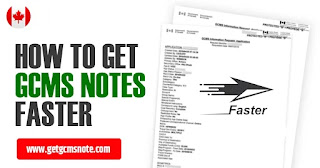How to Get GCMS Notes Faster: Your Comprehensive Guide
Introduction
If you're in the process of applying for Canadian immigration, you're probably familiar with the term "GCMS notes." These notes, officially known as Global Case Management System (GCMS) notes, are a crucial resource that can provide you with valuable insights into the status of your application and the decision-making process. However, obtaining GCMS notes can sometimes be a time-consuming and confusing process. In this comprehensive guide, we'll walk you through the steps to how to get gcms notes faster and efficiently.
What Are GCMS Notes?
GCMS notes are the internal documents used by Immigration, Refugees, and Citizenship Canada (IRCC) to record and document the details of your immigration application. These notes contain valuable information about the progress of your application, any concerns or issues that may have arisen, and the reasons behind the decisions made by immigration officers.
Getting access to your GCMS notes is like gaining access to the behind-the-scenes workings of your immigration application. It can help you understand why certain decisions were made and whether there are any issues that need your attention. Whether you're applying for a study permit, work permit, or permanent residency, GCMS notes can be a valuable resource in your journey.
Why Should You Get GCMS Notes?
Here are some compelling reasons why you should consider obtaining your GCMS notes:
Transparency: GCMS notes provide transparency into the immigration process. You can see how your application is progressing and whether there are any delays or issues.
Accuracy: By reviewing your GCMS notes, you can ensure that all the information provided in your application is accurately reflected in the system.
Troubleshooting: If there are any concerns or issues with your application, GCMS notes can help you identify them so you can take appropriate action.
Peace of Mind: Knowing the status of your application can provide peace of mind and reduce anxiety during the waiting period.
Now that you understand the importance of GCMS notes, let's dive into the steps to obtain them faster.
Step 1: Submit Your Application
The first and most crucial step in obtaining GCMS notes is to submit your application to IRCC. Whether you're applying for a study permit, work permit, or permanent residency, you must have an active application in the system. Keep in mind that GCMS notes are only available for applications that are in progress.
Step 2: Wait for Processing
Once your application is submitted, it will go through various stages of processing. The processing time can vary depending on the type of application and the workload at the time. It's essential to be patient during this phase and allow IRCC officers to assess your application thoroughly.
Step 3: Obtain Your Unique Client Identifier (UCI)
To request your GCMS notes, you'll need your Unique Client Identifier (UCI). This is a unique number assigned to you by IRCC when you submit your application. You can find your UCI on any official correspondence you've received from IRCC, such as your application acknowledgment letter.
Step 4: Prepare Your Request
Before you can request your GCMS notes, you'll need to prepare a formal request. Here's what you need to include in your request:
Your full name
Date of birth
UCI (Unique Client Identifier)
Current address
Contact information
A brief statement expressing your desire to obtain your GCMS notes
Step 5: Choose Your Request Method
There are two primary methods for requesting your GCMS notes: through the Access to Information and Privacy (ATIP) process or by using an immigration consultant or representative.
Option 1: Access to Information and Privacy (ATIP) Request
This is the most common and cost-effective method. To submit an ATIP request, you can follow these steps:
Visit the official ATIP Online Request page on the Government of Canada website.
Select "Access to Information Request" and then "Immigration, Refugees, and Citizenship Canada (IRCC)" as the institution.
Fill out the online ATIP request form with your personal information and request details. Be sure to specify that you are requesting your GCMS notes.
Pay the required processing fee. As of my last knowledge update in September 2021, the fee was $5.00 CAD.
Submit your request.
Option 2: Use an Immigration Consultant or Representative
If you have an immigration consultant or representative assisting you with your application, they can request your GCMS notes on your behalf. They will have access to the appropriate channels and can expedite the process for you.
Step 6: Wait for Processing
After you've submitted your request for GCMS notes, you'll need to wait for processing. The processing time for ATIP requests can vary, but it typically takes several weeks to receive a response. If you chose to use an immigration consultant or representative, they will keep you updated on the progress of your request.
Step 7: Review Your GCMS Notes
Once your request is processed, you will receive your GCMS notes electronically or by mail, depending on your chosen method. Review the notes carefully, and if you have any questions or concerns, consider consulting with an immigration expert for clarification.
Conclusion
Obtaining your GCMS notes can be a valuable step in your Canadian immigration journey. It provides transparency, accuracy, and peace of mind during the application process. While the process may take some time, following these steps will help you get your GCMS notes faster and more efficiently. Remember to be patient and stay informed about the status of your application. With GCMS notes in hand, you'll have a better understanding of your immigration application and can make informed decisions to ensure a smoother transition to life in Canada.




Comments
Post a Comment